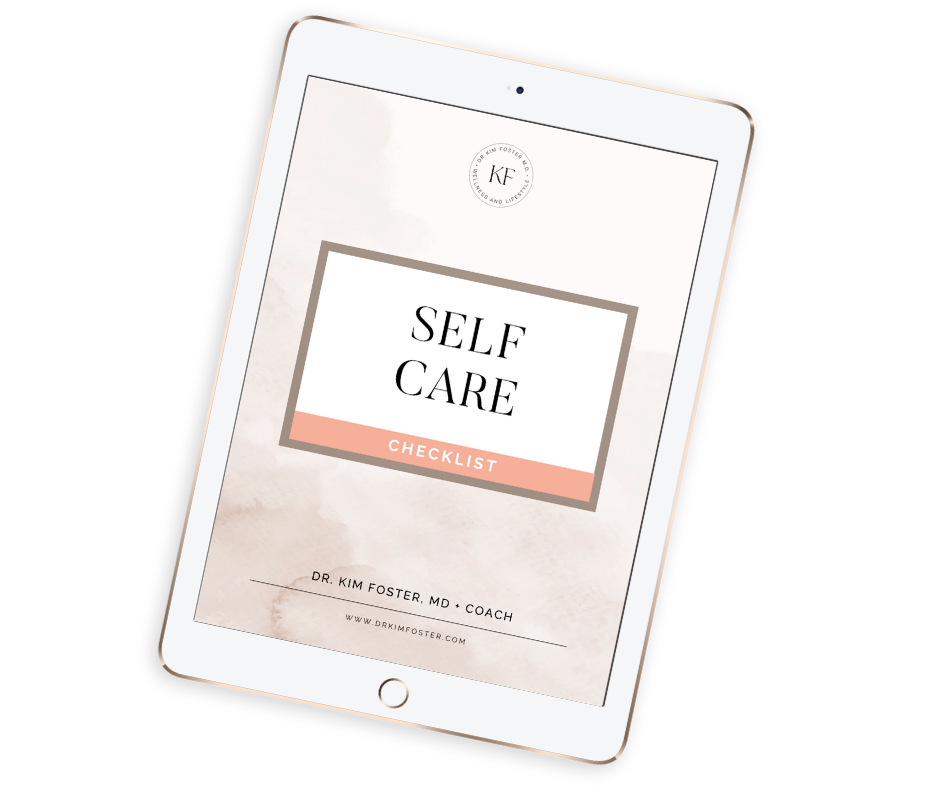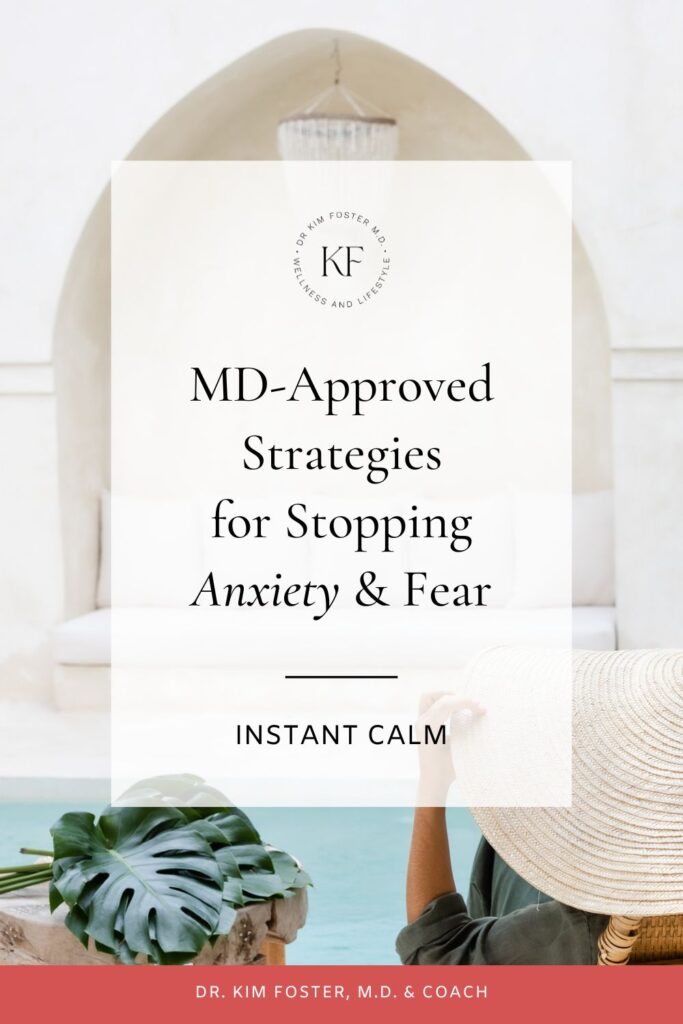Have you noticed how everyone seems to be talking about anxiety these days?
Perhaps you’ve personally been grappling with fear and anxiety lately, too?
It’s not surprising, as the latest research shows anxiety rates are rising more and more every year.
The American Psychiatric Association’s 2024 mental health poll found that a whopping 43% of adults feel more anxious than they did last year. This is up from 37% in 2023 and 32% in 2022!
As a doctor, I’ve seen countless patients struggle with these overwhelming emotions, but I’ve also seen them break through anxiety and regain control of their lives.
How did they do it?
In this week’s article and YouTube video, I’m sharing the science and practical steps you can take to stop anxiety in its tracks and unlock the most fearless version of yourself.
Let’s dive in!
Fear Vs. Anxiety Vs. Worry
We often use the terms fear, anxiety, and worry interchangeably, but the truth is they are three different psychological states.
Fear is an intense emotional response to a specific, immediate threat or danger, such as encountering a growling dog or seeing a car speeding towards you when crossing the street.
These threats and dangers trigger the body’s fight-or-flight response, leading to symptoms like:
- A racing heart
- Rapid breathing
- A surge of adrenaline.
The physical reaction to fear is intense but usually short-term. It typically lasts as long as the threat is present, then quickly dissipates once the danger has passed.
Anxiety is a generalized feeling of apprehension or dread about potential future threats or dangers. Often, an upcoming event will trigger this feeling, such as:
- Upcoming exams
- A job interview
- The first day at a new job
Anxiety can cause physical symptoms like increased heart rate, muscle tension, and sweating (just like fear). The difference is these symptoms are usually less intense than fear but can last much longer.
Remember, fear is a reaction to something present and identifiable, while anxiety can happen when there is no actual threat in sight.
Lastly, while fear and anxiety are emotional responses, worry is a cognitive process.
Worry involves repetitive, negative thoughts about future events, especially those with uncertainty or risk. It predominantly occurs in the brain, but if it persists, it can lead to physical symptoms.
The Science Behind Anxiety & Fear
Understanding where fear and anxiety come from is super empowering. When you know the science behind it, you know that there isn’t anything wrong with you. Instead, the fear you feel before an exam or interview is a natural bodily response.
Let me explain…
Our brains are wired to protect us from danger. When the amygdala, a part of the brain known as the ‘fear center,’ perceives a threat, it triggers the fight-or-flight response. This is when our body prepares to either fight against or run away from the danger.
Scientifically, the fight-or-flight response is the sympathetic nervous system kicking in to give you the necessary resources to fight or run away. These ‘resources’ manifest as the common symptoms of fear.
For example, your heart starts racing to send increased blood and oxygen to your muscles so that you can physically run away or fight for your life.
But here’s the thing…
Our fight-or-flight response hasn’t evolved to meet our modern lifestyles.
It served our ancestors well, who encountered regular physical threats, like wild animals chasing them.
But it doesn’t serve us modern humans well when we’re waiting for an interview, about to speak at an event, or taking an exam.
So, when our fight-or-flight response kicks in during these non-life-threatening situations, how can we let our bodies know that it is not needed?
Here’s the good news…
Regaining control in these situations and overcoming the fear is totally possible. In the next sections, I’ll share some specific, proactive strategies for doing so.
Note that the strategies to overcome fear are different from those that can help you overcome anxiety. So get clear on which emotional response you’re dealing with first.
Strategies For Tackling Fear
Let’s discuss how to neutralize those intense, heat-of-the-moment feelings that arise when something isn’t an actual threat or danger.
The first strategy is deep breathing.
Deep breathing is a grounding technique that reduces the intensity of fear by helping you reconnect to the present moment.
Slow, deep breaths calm your nervous system. They stimulate the vagus nerve, which promotes parasympathetic activity, the opposite of the sympathetic fight-or-flight response. This’ relaxation response’ immediately lowers your heart rate and blood pressure.
The deep breathing exercise I recommend is box breathing or four-square breathing. Navy SEALs commonly use it to calm their minds during stressful situations, which enhances focus and performance under pressure.
The second strategy is the five senses technique.
This quick and simple technique anchors you into your physical surroundings and gets you out of panic mode.
It’s all about stimulating all five senses to increase your awareness of your immediate environment. For example, you identify one thing you can see, hear, touch, smell, and taste.
Strategies For Tackling Anxiety
What about if it’s low-grade, daily anxiety you struggle with?
Anxiety can so easily take over our lives and steal our joy, but one method I have found super helpful for dealing with anxious feelings is meditation.
Meditation has been extensively studied for its ability to reduce chronic anxiety, and there is tons of scientific evidence supporting its effectiveness.
Meditation helps to train the brain to focus on the present moment, which alters our stress response, leading to lower levels of anxiety.
Neuroimaging studies show that regular meditation can lead to structural and functional changes in the brain. It increases gray matter density in brain regions associated with self-awareness, compassion, and introspection.
Meditation also decreases activity in the amygdala, which is involved in the stress response. It has also been found to lower cortisol levels, the body’s primary stress hormone.
The second strategy for dealing with anxiety is journaling.
Journaling is something I do whenever I feel the first symptoms of anxiety arise. There is something incredibly therapeutic about writing down all my thoughts and seeing them on paper. It helps me work through my feelings and gain clarity on the situation.
Journaling’s benefits are also backed by science.
Journaling:
- Reduces feelings of overwhelm
- Improves emotional regulation
- Lowers cortisol levels
Final Thoughts
If you’re interested in learning more about these strategies, watch the YouTube video, where I explain how to practice each one.
In the video episode, I also share two more effective strategies for overcoming fear and anxiety!
Here’s where you can watch:
Now I’d love to hear from you. Do you use any other strategies for managing anxiety and fear?
Share your ideas and insights in the comments below. That way, we all help each other!
Download my FREE Self-Care Checklist!


FREE CLASS!
Looking to take your wellness journey to the next level?
The 3 Secrets For Stepping Into A Meaningful New Career Without Wasting Time Or Money
- find out why health & wellness coaching is a skyrocketing industry that can provide the freedom and fulfillment you’ve been craving
- discover the 3 biggest myths about health & wellness coaching that will hold you back (and what the truth is instead)
- learn the secret sauce for getting amazing results for your clients (and building a profitable business as a wellness coach)
…and more!







